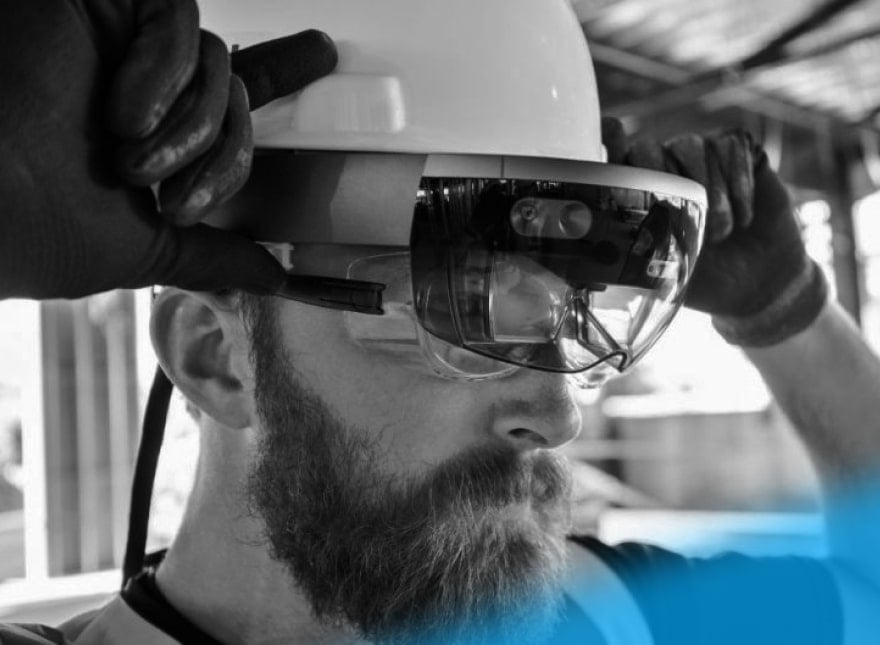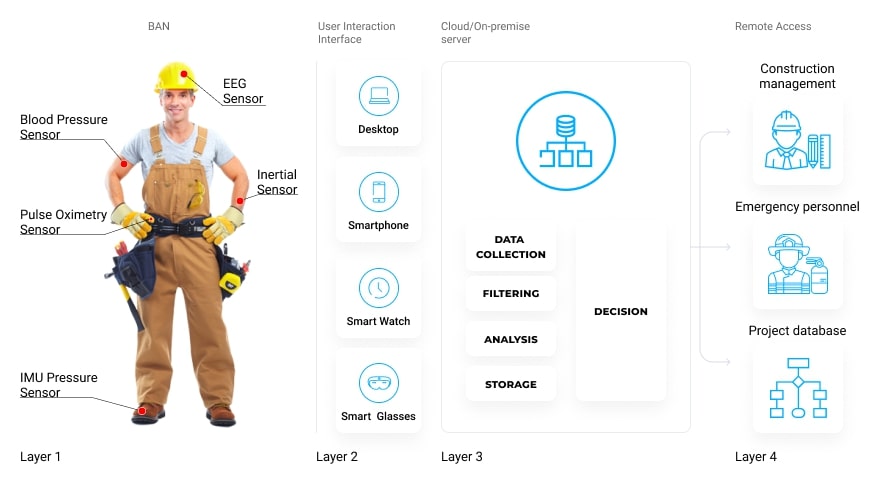Check out our latest blog article: From component to enterprise – modular robotics done right.
Wearables Improve Construction Site Safety. Here's How

The construction industry is a slow adopter of new technologies. There are numerous reasons for this: the underinvestment in digitization, focus on traditional building methodologies, aging workforce, and cultural factors. As a result, new technologies like wearables, which can bring drastic improvement to a construction site, are still in a nascent stage here and haven’t demonstrated their full potential yet.
But experts are waiting for this situation to change in the near future. The reason is a growing demand for novel strategies that promote construction workers’ safety, as traditional methods have proved to be insufficient for reducing the proportion of fatal and non-fatal accidents occurring on a construction site.
In 2018, one out of five worker deaths happened in construction, with 58,6% of them attributed to the Fatal Four accidents: falls (33,5%), being struck by object (11,1%), electrocutions (8,5%), caught-in/between (5,5%).
In such circumstances, a wider adoption of technological advances, namely wearables, becomes both a tactical and strategic solution, as it will help attract younger employees to the sector.
Wearable Solution Architecture: Components and Structure
Construction employees are exposed to both physiological and environmental risk factors. These include fatigue, microsleeps, changing locations, work in dynamic project conditions, and many others.
Hence, a technology solution for construction site safety should analyze biometric data, which is collected via wearable devices, and geolocation data, which comes from BLE-based real-time locating systems (RTLSs), satellites, RFID tags, and environmental markers.
A wearable solution for construction site safety features three major components:
Hardware
Hardware would include any object with a chip: sensors embedded in wearables (safety helmets, clothes, footwear), tags attached to walls and site equipment, and so on. Sensors like galvanic skin response (GSR), accelerometers, gyroscopes, and magnetometers constitute a body sensor network, which comprises sensors placed in the human body, on the body surface, or around the body.
Are you going to implement custom smart devices into your real estate business? Partner with us to design any type of sensor or electronics system for better process management, improved worker safety, and informed strategic planning.
Communication gateways
The components exchange data between sensors and send it to remote servers for further analysis and storage. They also process the received data on the edge for fast responses.
Wearable solutions for construction site safety exchange data at three levels:
- Body Area Network (BAN). Such networks connect body-worn sensors. They usually have a short range and are powered by Bluetooth and Zigbee.
- Personal Area Network (PAN)/Local Area Network (LAN). A wireless PAN (WPAN), such as Bluetooth, or wireless LAN (WLAN), for example, Wi-Fi, collects data from sensors and transmits it to a cloud or on-premise server.
- Wide Area Network (WAN). These networks are based on a distributed infrastructure. Data exchange is provided by GPS satellite communication, cellular and Worldwide Interoperability for Microwave Access or metropolitan area networks, and internet protocols (IPs) providing the connection to the Internet.
Software
These components, including middleware and an application, are responsible for computation, analysis, storage, visualization, and analytics, based on the application’s requirements. Data analysis and embedded intelligence make systems context-aware and adaptive: after processing biometric and geolocation data, they send alerts about related health hazards.
The components form the following 4-layer typical architecture:

Traditionally, safety in construction has been managed reactively, as a response to accidents that have already occurred. Wearables ensure proactive safety monitoring, measurement, and management for accident prevention. They also assist with construction site navigation, coaching, responsive learning, and remote data sharing and access.
Here is an overview of the most promising wearable personal protective equipment (PPE) solutions, which enable continuous monitoring of a wide range of vital signals, such as heart rate, breathing rate, and posture, and provide early warning systems for workers with high-risk health issues.
Type 1: Smart Caps
Safety helmets feature a headband that tracks electroencephalogram (EEG) brain waves. Once the integrated algorithms identify an increased tiredness level or microsleep, the system pushes voice and/or vibration alerts to a connected mobile app or another device of choice.
Smart caps can be camera-free or feature a camera that not only records events, but also helps with navigation and location.
Areas for Improvement
Currently, smart caps rely on universal measurements to function. But brain activity remains a very individual subject, featuring different levels of drowsiness. To be efficient, smart caps need to be based on advanced fatigue detection algorithms.
That’s why we are likely to see a rise in Machine Learning (ML) development for wearables. ML methods apply algorithms to the extracted individual fatigue descriptors (IFDs), like electromyographic (EMG) and heart rate variability (HRV) measurements, classify corresponding fatigue levels, help identify emerging safety risks, and streamline data-driven safety management decisions.
Type 2: Smart Eyewear
Combined with AR, smart glasses allow wearers to use voice control to live-stream digital images in their field of view while keeping their hands free. They can also receive notifications once they approach a dangerous area and follow real-time instructions from remote experts.
Areas for Improvement
To make the wearable device a useful tool and not a distracting nuisance, workers need special training and time for adaptation in order to properly handle the influx of wireless data coming onto their smart glasses.
To get the most out of the devices, AR, motion sensors, and GPS data should be incorporated to assist in 3D real-time navigation and virtual tours. Additionally, if there's an accident at the worksite, the device should relay the worker's location for emergency responders.
Type 3: Smart Vests
Smart e-textiles feature embedded sensors, which monitor a wearer’s physiological condition: body temperature, blood pressure, pulse rate, muscle strain, or any other biomedical criteria. They also detect heat-stress conditions and generate prompt alerts in response to real-time accidents.
The tiny sensors communicate with each other, forming a BAN, and update the data on the worker’s smartphone or the computer in the site office.
Areas for Improvement
Smart garments, such as vests and jackets, are in their infancy, especially in the areas of energy harvesting and hardware miniaturization. This means that charging and battery life still represent a research problem.
Another challenge is fighting the influence of washing processes, temperature, sweat, moisture, bending, and compression to ensure smart garments’ durability against deformation.
Type 4: Smart Boots
According to the Global Market Insights report, the industrial safety footwear market will be growing at a CAGR of 6% by 2026. Smart boots feature sensors for temperature detection, GPS, Wi-Fi, and inertial measurement units (IMUs) to track location and motion, and more. Some examples of connected footwear, like SolePower boots, are powered by a kinetic charger, harnessing the energy produced by walking.
Interactive smart shoes collect data, including gait characteristics and activity patterns, analyze the surrounding environment, provide information on real-time location, and send it to a mobile or desktop app. This way, they alert managers in case of an accident or a slip, helping safety personnel to respond promptly.
Areas for Improvement
There is still a lot of research to be done before intelligent footwear is widespread in the construction industry. Lightweight construction and intelligent sensors must be improved, as well as data latency and communications that allow safety personnel to react quickly in accidents.
Type 5: Smart Watches
Despite a growing number of new wearable technologies, wristbands remain the most popular devices, featuring the highest consumer interest level, which makes their adoption easier for construction workers.
Smart watches allow managers to monitor their workers’ performance and keep track of their health metrics. They also enable the latter to communicate with co-workers, keep track of tasks, and get coaching when needed.
Areas for Improvement
Despite the commercial success of smartwatches on the consumer market, they need a serious upgrade to become fit for the construction industry and ensure the accuracy of sensor data.
So far, multiple studies have shown that wearable devices are reasonably accurate while the user is at rest but demonstrate a radical increase in absolute error during activity. With smartwatches, one of the most common reasons for error is motion artifact, i.e., displacement of embedded sensors over the skin, which results in incorrect calculations.

Take-Home Message
The construction industry is changing, and soon we will observe a lot of new projects launched in this high-risk market, along with a wider adoption of innovative safety management programs.
The Center for Construction Research and Training has calculated that construction employers spent 3.6% of their total costs on injury-related medical expenses, rehabilitation costs, and workers’ compensation payments. Investing in technologically advanced safety programs, including wearable devices, will pay off both in financial and ethical terms.
More articles on the topic



![[Webinar] T-Winning Strategies: How Digital Twins Drive Innovation & Efficiency](https://www.softeq.com/hubfs/Digital%20Twins%20Webinar.png)
![[Webinar] Wearables: Past, Present, & Future](https://www.softeq.com/hubfs/Blog%20Featured%20Image.png)

